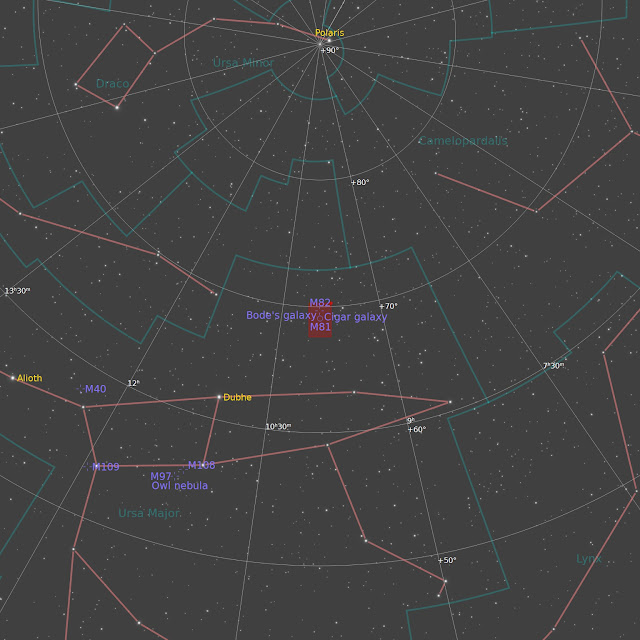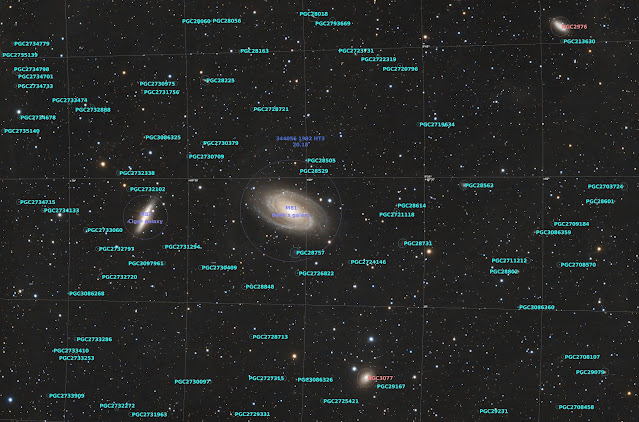Working on the New Camera
Sunday night April 9th (2023) was a clear night. Clear nights have been far and few between this year. Took the opportunity to work on optimizing the setup for my camera. In January of this year, I purchased my first Dedicated Astronomy Camera, the ZWO ASI2600MC Pro. Quite the step up from my DSLR. In the few opportunities that I've had to use the camera, confirmed that I have sensor tilt (the sensor is not square to the optical path). Spent the first night working on that, with some success (took the tilt from Severe to mild). The skies were amazing and I stopped making adjustments. Will need to make a few more subtle tweaks next clear night, didn't want to waste any more imaging time. Since it was a work night, was looking for a target that didn't require many hours of integration. Aha! M44, The Beehive Cluster. This checked a few boxes like: didn't require many hours of exposure, would be a good target to evaluate impact of adjustment as it's all stars, was well placed in the sky, and I love looking at this cluster through binoculars. Star Clusters aren't necessarily the "sexiest" choice of targets compared to Nebulae and Galaxies, but I have a soft spot for them, so this won't be the last cluster I image.
 |
| Messier 44 (M44) also known as The Beehive |
What is it?
Messier 44, also known as The Beehive or Praesepe, is an open star cluster located in the constellation of Cancer. Unlike many of the Nebulae and Galaxies we image, open star clusters are great visual targets. M44 is even Naked Eye visible from dark skies, appearing as fuzzy star. Optical Aid, preferably binoculars or a wide field refractor (in my opinion) will reveal the individual stars. binoculars will reveal about 75 stars with larger telescopes revealing more. The cluster contains about 100 members, most of which are M dwarfs. The mass of the cluster is about 500 times the mass of our Sun. The best time to view this cluster for northern latitude observers is from February through May.
How big is it?
M44 is about 95' (arcminutes) in diameter. The cluster is 16 light-years across.
How old is it?
The cluster is about 600 -700 million years old.
How far is it?
577 light-years or 177 parsecs from Earth.
How to find it?
When we observe many of the objects that we typically image with our visual observing equipment, we typically don't see the same color and details. This does not make visual observing less valid or impactful, just a different experience. However, star clusters are an (generally speaking) exception. They will also punch throw light pollution, of course the view is always better in dark skies. Star clusters like M44 are often excellent objects to observe in binoculars and telescopes with a wider field of view due to their angular size in the night sky. for perspective, M44 is 95' across and the Full moon is only about 30'. These factors combine to make star clusters an excellent choice for visual observation for a wide range of astronomers and their respective equipment. Personally, this is one of my favorite springtime targets to visually observe.
Finding M44 is pretty easy even though the constellation of Gemini is a very dim constellation. Refer to the finder chart below and follow these steps:
- Find the bright star Pollux in the constellation of Gemini, in the West-Southwest sky this time of year (late April/early May).
- Find the bright Regulus in the constellation of Leo. Look for the Sickle asterism or the backwards question mark. Regulus will be the bright star at the bottom. At the time of this blog post (late April/early May) Regulus is high in the sky almost due South, just past the Meridian, towards the West, at dark. The Meridian is an imaginary line in the sky from North to South, dividing the celestial sphere into East and West.
- Point your binoculars or your telescope's finder almost halfway between both stars to find the cluster of stars.
 |
| Finder Chart for M44 |







